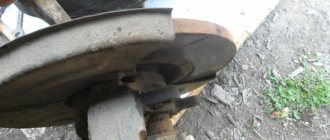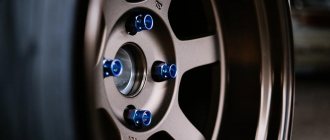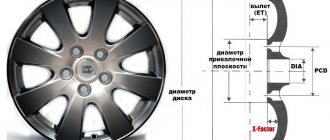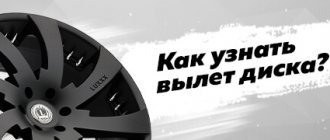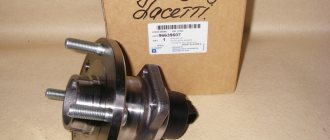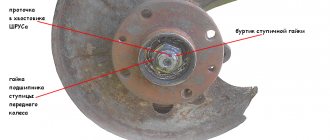Disc markings Car wheels are divided into two types - standard and additional. Standard information includes information about the width of the rim, the type of edge, rim split, mounting diameter, ring lugs, offset, etc.
As for additional markings, this includes information about the maximum permissible load, the maximum permissible tire pressure, information about the methods of manufacturing the disk, information about the international certification of a particular disk. However, not every car rim will have all the information listed above. Most products provide only some of the information provided.
Where are the markings on the discs?
As for the location of the inscription on alloy wheels, the corresponding information is usually indicated not around the perimeter of steel wheels, but on the spokes or on the outer side between them (at the location of the holes for mounting on the wheel). It all depends on the design of the particular disk. Typically, the inscriptions are located on the inside of the wheel spokes. Along the circumference of the hole for the hub nut, between the holes for the wheel bolts, some separate information is applied that relates to the size of the disk and its technical information.
On stamped discs, the markings are stamped on the surface on the inside or outside. There are two types of application. The first is when individual inscriptions are applied to the intermediate space between the mounting holes of the disks. In another version, information is indicated simply along the perimeter of the rim closer to its outer edge. On cheap drives, the second option is more common.
Hub diameter for different cars
Each car has its own list of permissible wheel diameters. The parameters may change, you can usually find them out by the sticker next to the driver’s seat or from the technical characteristics of the car. The variety of diameters of the central hole sometimes confuses buyers. They sometimes differ by literally 0.1 mm. There are no uniform standards, so some manufacturers indicate data more accurately, while others less so. Some self-respecting disk manufacturers go further and indicate indicators not of 1/20 of a millimeter, but up to as much as 10 microns, i.e. up to 0.01 mm. What standards are accepted for cars of the most popular brands?
- The diameter of the central hole of the VAZ disk will be 58.6 mm.
- The same figure for Audi is 57.1 mm.
- The diameter of the central hole of the Honda disc is 64.1 mm.
- For BMW, the hub diameter ranges from 74.1 to 72.6 mm.
- In Citroen cars, the indicators also vary - you can find cars with a central hole diameter of 65.1 and 58.1 mm.
- Fords also have a wide range of sizes: 57.1; 63.4 and 64.1 mm.
Typical wheel rim markings
Marking of wheels for cars
When choosing new rims, many car enthusiasts are faced with problems related to the fact that they do not know the meaning of rims, and, accordingly, do not know which ones are suitable for a particular car and which ones are not.
On the territory of the Russian Federation, the UNECE Rules are in force, in particular, the Technical Regulations of Russia “On the safety of wheeled vehicles” (GOST R 52390–2005 “Wheels. Technical requirements and test methods”). Accordingly, all the necessary information can be found in the specified official document. However, for most ordinary motorists, the information provided there will be unnecessary. Instead, when choosing, you need to know the basic requirements and parameters, and, accordingly, their decryption directly on the disk.
Marking of alloy wheels
Most of the parameters listed below are also relevant for alloy wheels. However, what distinguishes them from their steel counterparts is that on the surface of the cast wheels there will additionally be an X-ray inspection mark, as well as the mark of the organization that carried out this test or has the appropriate permission to do so. They often also contain additional information about the quality of the disc and its certification.
Marking of stamped discs
The marking of disks, regardless of their types, is standardized. That is, the information itself on cast and stamped discs will be the same and simply reflect technical information about a particular disc. Stamped discs usually contain technical information and often the manufacturer and country where it is located.
Decoding disk markings
Standard markings on car wheel rims are applied directly to its surface. To understand what information is responsible for what, let’s give a specific example. Let's say we have a car wheel with the designation 7.5 J x 16 H2 4×98 ET45 d54.1. Let us list its decoding in order.
Rim width
The width of the rim is indicated by the first number in the designation , in this case it is 7.5. This value indicates the distance between the inner edges of the rim. In practice, this means that tires of suitable width can be installed on this rim. The fact is that you can install tires in a certain width range on each rim. That is, the so-called high-profile and low-profile. Accordingly, the width of the tires will also be different. The best option for choosing a rim for car wheels is the tire width, which is approximately in the middle of the tire size. This will allow you to install tires of different widths and heights on the disc.
Rim edge type
The next marking of car rims is the type of edge. In accordance with European and international regulations, the type of edge can be designated by one of the following Latin letters - JJ, JK, K, B, D, P for passenger cars and E, F, G, H for truck wheels. In practice, the description of each of these types is quite complex. In each case, we are talking about the shape or diameter of the disc contour , and in some cases, the angle of inclination of the rim edges . This parameter is proprietary information, and it does not provide any useful information for a particular car enthusiast. However, you may need this designation of markings on the disk when you are familiar with the requirements of the car manufacturer and are interested in what type of edge should be on the disk for a car of your brand.
For example, wheels labeled JJ are intended for SUVs. The disc marked with the letter P is suitable for Volkswagen cars, the disc with the letter K is suitable for Jaguar cars. In particular, the manual clearly indicates which discs are suitable for a particular machine and the choice must be made in accordance with the specified requirements.
Rim connector
The next parameter of the rim is its detachability. In this case, there is a designation with the English letter X. This symbol indicates that the design of the disk itself is one-piece , that is, it is a single product. If instead of the letter X the symbol “–” is written, this means that the rim is detachable, that is, it consists of several parts.
Most rims for passenger cars are one-piece. This allows you to install so-called “soft” tires on them, that is, elastic ones. Split disks are usually installed on trucks or SUVs. This allows you to install hard tires on them, for which, in fact, the collapsible design was made.
Mounting diameter
After the information about the disc connector in the marking there is a number indicating the diameter of the wheel rim, in this case it is 16. It corresponds to the diameter of the tire . For passenger cars, the most popular diameters are from 13 to 17 inches. Large rims and, accordingly, tires wider than 17'' (20-22'') are installed on cars with powerful engines, including various SUVs, minibuses or trucks. In this case, when choosing, it is necessary to take into account that the diameter of the tire exactly matches the diameter of the rim.
Ring lugs
Another name is ring tackles or humps. In this example they are designated H2. These are the most common disks. The information means that the design of the disc involves the use of protrusions for fixing tubeless tires located on both sides. This ensures a more secure attachment to the disk.
If there is only one H symbol on the disc, this means that the protrusion is located on only one side of the disc. There are also several other similar designations for protrusions. In particular:
- FH - Flat Hump;
- AH - asymmetric tackle (Asymmetric Hump);
- CH - combined hump (Combi Hump);
- SL - there are no protrusions on the disc (in this case the tire will hold on to the edges of the rim).
Two humps increase the reliability of fixing the tire on the disk and reduce the likelihood of its depressurization. However, the disadvantage of a double hump is that it is more difficult to get the tire on and off. But if you regularly use tire fitting services, this problem should not interest you.
Fastening parameters (PCD bolt pattern)
The next parameter, namely 4×98, means that this disk has four mounting holes of a certain diameter through which it is attached to the hub. On imported rims, this parameter is designated as PCD (Pitch Circle Diameter). In Russian it also has the definition of “boltovka”.
The number 4 indicates the number of mounting holes. In English it is designated LK. By the way, sometimes fastening parameters can look like 4/98 in this example. The number 98 in this case means the diameter of the circle around which the indicated holes are located.
Most modern passenger cars have four to six mounting holes. Less commonly, you can find discs with the number of holes equal to three, eight or even ten. Typically, the diameter of the circle around which the mounting holes are located is from 98 to 139.7 mm.
When choosing a disk, be sure to know the size of the car’s hub, since often inexperienced car enthusiasts, when choosing a new disk, try to set the appropriate value “by eye.” The result is the choice of an unsuitable disk for mounting.
Interestingly, for discs that have four mounting bolts, the PCD distance is equal to the distance between the centers of diametrically located bolts or nuts. For those drives that are equipped with five mounting bolts, the PCD value will be equal to the distance between any adjacent bolts multiplied by a factor of 1.051.
Some manufacturers produce universal rims that can be installed on various hubs. For example, 5x100/120. Accordingly, such discs are suitable for various cars. However, in practice it is better not to use such disks, since their mechanical characteristics are lower than those of conventional ones.
Offset markings on wheels
In a specific example, the symbols in the ET45 (Einpress Tief) disk marking mean the so-called offset (in English you can also find the definition OFFSET or DEPORT). This is a very important parameter when choosing. In particular, the disc offset et is the distance between the vertical plane , which conventionally runs in the middle of the wheel rim , and the plane corresponding to the point of contact between the disc and the car hub . There are three types of wheel rim offsets:
- Positive . In this case, the central vertical plane (plane of symmetry) is located further from the center of the car body in relation to the plane of contact between the disk and the hub. In other words, the disc is the least convex from the body of the machine. The number 45 means the distance in millimeters between the two indicated planes.
- Negative . In this case, on the contrary, the plane of contact between the disk and the hub is located further from the central plane of symmetry of the disk. In this case, the disc offset designation will have a negative value. For example, ET-45.
- Zero . In this case, the plane of contact between the disk and the hub and the plane of symmetry of the disk coincide with each other. In this case, the disk is marked ET0.
When choosing a disk, it is very important to know information about which disks the car manufacturer allows to install. In some cases, it is only possible to install disks with a positive or zero offset. Otherwise, the car will lose stability and problems may arise when driving, especially at speed. The permissible error in wheel rim offset is ±2 millimeters.
The disc offset value affects the width of the car's wheelbase. Changing the offset can lead to increased load on the suspension and problems with car handling!
Bore hole diameter
When selecting a disk, you will need to know what dia means in the disk marking. As the name implies, the corresponding number indicates the diameter of the mounting hole on the hub in millimeters . In this case it is designated d54.1. This disk installation data is encrypted in the DIA notation.
For most passenger cars, the corresponding value is usually between 50 and 70 millimeters. It must be clarified before choosing a particular disk, otherwise the disk simply cannot be installed on the machine.
On many large-diameter alloy wheels (that is, with a large DIA value), manufacturers provide the use of adapter rings or washers (also called “instep supports”) for centering on the hub. They come in plastic and aluminum. Plastic washers are less durable, but for Russian realities they have a huge advantage. In particular, they do not oxidize and prevent the disc from sticking to the hub, especially in severe frost conditions.
Please note that for stamped (steel) wheels, the diameter of the hole for the hub must necessarily coincide with the recommended value prescribed by the vehicle manufacturer. This is due to the fact that steel wheels do not use adapter rings.
If the machine uses a cast or forged disk, then the diameter of the hole for the hub is determined by the size of the plastic bushing. Accordingly, it needs to be selected additionally for a specific car, in particular, after selecting a specific disk for the car. Typically, the automaker does not install adapter rings on original car rims, since the rims are initially manufactured with a hole of the required diameter.
Results
Experienced motorists often say that you should never save on two parts of your car - wheels and brakes. What diameter of the central hole of the wheel rim needs to be chosen so that the car drives like clockwork? This parameter is not the main one when choosing a “new thing” for your car. But it is certainly worth considering when purchasing; do not take a size smaller than the diameter of the hub. But if you take a disk with a hole slightly larger than necessary, then nothing bad will happen. The main thing is to contact a trusted tire shop, which will install new wheels with all the additions necessary for your safety.
Additional markings of disks and decoding of their designations
The parameters listed above are fundamental when choosing a wheel for a car. However, on some of them you can find additional inscriptions and markings. For example:
- MAX LOAD . This abbreviation means what is the maximum permissible load allowed for a particular wheel rim. Typically the number is expressed in pounds (LB). To convert a value in pounds to a value in kilograms, simply divide by a factor of 2.2. For example, MAX LOAD = 2000 LB = 2000 / 2.2 = 908 kilograms. That is, disks, like tires, have a load index.
- MAX PSI 50 COLD . In this particular example, the inscription means that the maximum allowable air pressure in the tire mounted on the rim should not exceed 50 pounds per square inch (PSI). For reference, pressure equal to one kilogram-force is approximately 14 PSI. To convert the pressure value, use a calculator. That is, in this particular example, the maximum permissible tire pressure should not exceed 3.5 atmospheres in the metric coordinate system. And the inscription COLD means that the pressure must be measured in a cold tire (before the car starts moving, including not under the scorching sun).
- FORGET . This inscription means that a particular disc was made using the forging method (that is, forged).
- BEADLOCK . This means that the wheel is equipped with a so-called tire locking system. Currently, it is prohibited to use such disks for security reasons, so they are no longer commercially available.
- BEADLOCK SIMULATOR . Such an inscription indicates that the disk contains a simulator of the tire fixation system. In this case, such disks can be used everywhere. In practice, this means that these disks are no different from ordinary ones.
- SAE/ISO/TUV . These abbreviations refer to the standards and regulatory bodies to which the discs were manufactured. On domestic tires you can sometimes find GOST values or manufacturer specifications.
- Date of manufacture . The manufacturer indicates the corresponding production date in encrypted form. This is usually four digits. The first two of them mean the week in a row, starting from the beginning of the year, and the second two - the year of manufacture itself. For example, the designation 1217 indicates that the disc was manufactured in the 12th week of 2022.
- Country of manufacture . On some discs you can find the name of the country in which the product was manufactured. Sometimes manufacturers only leave their logo on the disc or simply write the name.
Markings on Japanese wheels
On some discs produced in Japan, you can find the so-called JWL marking . Translated from English, the abbreviation means Japanese alloy wheels. This marking is applied only to those discs that are sold in Japan. Other manufacturers may apply the appropriate abbreviation if desired. However, if it is on the disk, it means that the disk meets the requirements of the Ministry of Land, Infrastructure, Transport and Tourism of Japan. By the way, for trucks and buses the similar abbreviation will be slightly different - JWL-T.
There is another non-standard marking - VIA . It is applied to the disc only if the product has passed successful tests in the laboratory of the Japanese Transport Inspection. The abbreviation VIA is an officially registered trademark. Therefore, applying it to discs that have not passed the appropriate tests is punishable. Therefore, discs on which the indicated abbreviation is printed will initially be of very high quality and durable.
How to choose a wheel rim
When choosing a particular disc, car owners often have a problem - how to choose the right disc in accordance with the available tires. Let's look at a specific example of tires marked 185/60 R14. The width of the rim, in accordance with the requirements, must be 25% less than the width of the tire profile. Accordingly, it is necessary to subtract one quarter from the value of 185 and convert the resulting value into inches. The result will be five and a half inches.
Please note that for wheels with a diameter of no more than 15 inches, deviation in width from ideal conditions is allowed by no more than one inch. If the wheel is more than 15 inches in diameter, then the permissible error may be one and a half inches.
Thus, after the above calculations, we can say that for a 185/60 R14 tire a disk with a diameter of 14 inches and a width of 5.5...6.0 inches is suitable. The remaining parameters listed above must be clarified in the technical documentation for the car.
The following is a table that summarizes information about standard (factory) installed disks acceptable by their manufacturers. Accordingly, for cars it is necessary to choose wheels with suitable parameters.
| Automobile model | Factory wheel sizes and details |
| Toyota Corolla 2010 | 6Jx15 5/114.3 ET39 d60.1 |
| Ford Focus 2 | 5JR16 5×108 ET52.5 DIA 63.3 |
| Lada Granta | 13 / 5.0J PCD 4×98 ET 40 CO 58.5 or 14 / 5.5J PCD 4×98 ET 37 CO 58.5 |
| Lada Vesta 2022 release | 6Jx15 4/100 ET50 d60.1 |
| 2022 Hyundai Solaris | 6Jx15 4/100 ET46 d54.1 |
| 2015 Kia Sportage | 6.5Jx16 5/114.3 ET31.5 d67.1 |
| Kia Rio | PCD 4×100 with diameter from 13 to 15, width from 5J to 6J, offset from 34 to 48 |
| Niva | Bolt pattern - 5×139.7, offset - ET 40, width - 6.5 J, centering hole - CO 98.6 |
| Renault Duster 2011 | Size - 16x6.5, ET45, bolt pattern - 5x114.3 |
| Renault Logan 2022 | 6Jx15 4/100 ET40 d60.1 |
| VAZ 2109 2006 | 5Jx13 4/98 ET35 d58.6 |
Pros and cons of enlarging the center hole
What does the central hole affect, and will the technical parameters of the car change if it is enlarged? The positive aspects of a disk with a universal central diameter include:
- Availability – these discs can be found everywhere. As a rule, they are produced for a large number of brands and models, so choosing the one you need will not be difficult.
- Versatility - wheels with a large central hole fit many models.
- Price – since such a product is produced in large quantities, the price for it is slightly lower than for “exclusively” selected discs.
